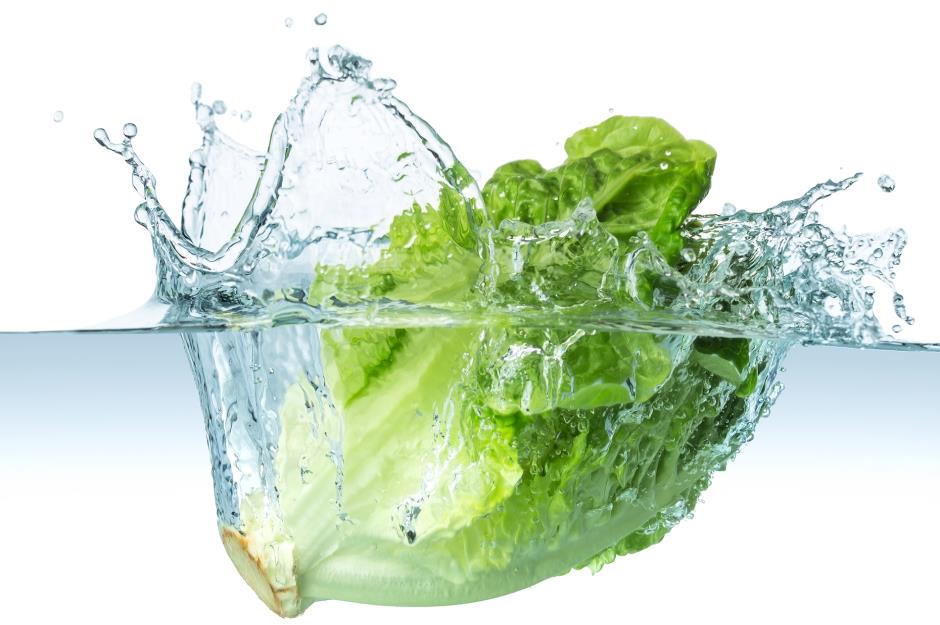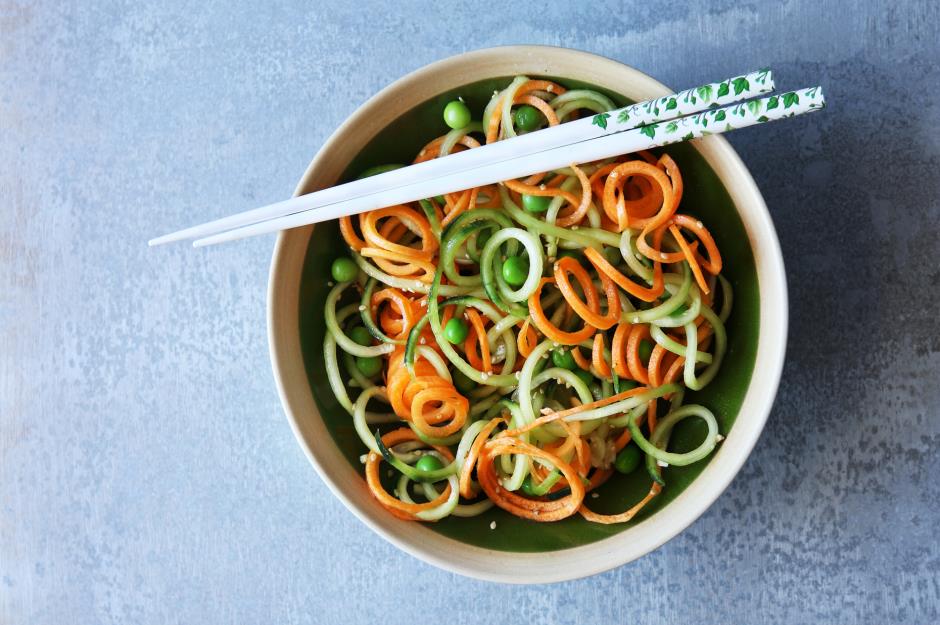How to make tastier and better-looking salads
Salad days are here
Ditch the knife
A peeler or spiraliser will turn the likes of carrots, cucumbers and courgettes into gorgeous ribbons, turning your salad into something way more attractive and contemporary.
Get to grips with greens
Using the right lettuce can make all the difference to a salad. There are a number of varieties including: butter, small with a creamy texture; gem, petite and crisp and perfect as lettuce cups; iceberg, crunchy and ideal in a wedge salad; leaf, pretty, mild-tasting leaves that work in delicate salads; oak leaf, lovely-looking leaves with a mild sweetness; and romaine, textural and the right lettuce variety for Caesar salad.
How to prevent soggy salad greens
Salad leaves are delicate and tend to go limp quite quickly. The best way to give leaves longevity is to wash the leaves, spin the excess moisture off in a salad spinner and pat dry. It’s important that the leaves are dry before they are wrapped loosely in some paper towels and placed in a re-sealable plastic bag. Remove any air and store in the fridge.
Eat your way around the world
Caesar, Cobb, wedge and Waldorf are all delicious American salads but there are many more from around the globe. Try a French niçoise, a Guatemalan fiambre, a Laotian larb, a Middle Eastern tabbouleh, an Indonesian gado-gado, a Russian dressed herring or a Thai green papaya salad.
Embrace raw kale
Raw kale isn’t tough if you remove the stalks and cut the leaves into thin ribbons then massage it in a dressing of lemon juice, olive oil and salt for a few minutes. This process will soften the leaves. Mix the kale in with other ingredients such as avocado, or orange segments and pomegranate, or eat it on its own with Parmesan shavings.
For a faint taste of garlic
If you enjoy a touch of garlic but not too much then rub a couple of peeled garlic cloves (or a whole head cut in half) around the salad bowl before tossing the salad.
For that raw onion flavour without the tang
If you love the taste and crunch of raw onions but find they dominate a salad, peel then submerge them in ice cold water for 10-20 minutes before patting dry and adding to the dish. The salad will have an oniony aroma and crunch without being overpowered.
Go with the grain
Salads don’t just have to be about leaves and veggies – adding grains will add fibre, texture and make a dish more filling. Brown rice and ancient grains such as freekeh, millet and quinoa are a healthy source of protein and they’re full of nutrients. Cook, season, then include in a salad.
Give peas a chance…
Peas such as garden peas, sugar snaps and petit pois, as well as protein-rich chickpeas, add colour, flavour and texture to salads. Chickpeas absorb flavours well so are even better marinated a few hours beforehand in olive oil, lemon juice, garlic and herbs. Alternatively, fry up some chickpeas in olive oil, season and toss into a salad for crunch.
…and tofu too
Vegetable protein such as soy-based products tofu and tempeh and the wheat protein seitan – a meat substitute made from wheat gluten – are great for vegetarians, vegans and meat eaters. They add iron and protein to salads without the need for heavier meat products and, like chickpeas, can be marinated beforehand for extra flavour.
Hold back the dressing until serving
Made a salad to eat later? Don’t dress your salad until the last minute – it will go soggy. Instead put your condiment of choice in a mini bottle to apply just before eating.
How to revive wilted leaves
Make the most of mustard dregs
Rather than throwing away an almost-empty jar of mustard take the lid off, pour in some vinegar and olive oil and shake – you’ll get a delicious mustard dressing and will clean the jar in the process!
Make a rainbow
Colour makes people happy and food appealing, and in a salad gives the dish more nutritional weight. Think red tomatoes or leaves, green cucumber or beans, purple cabbage or kidney beans, yellow pepper and white rice.
Mason jars are salads’ friends
Mason jars are ideal airtight salad containers and you can make a few in advance. Layering is important: as a general rule the dressing goes at the bottom; then harder ingredients such as cucumbers, onions and peppers; next delicate avocado (dip in lemon juice to prevent it turning brown), beans, mushrooms and courgette; then cooked grains, pasta or couscous; then protein such as cheese, meat or tofu. Delicate leafy greens and herbs go on top, then greaseproof paper and nuts, seeds and croutons.
No need to ditch the crisps
Scattering crisps or tortilla chips on top of a salad means you can get a taste of a treat while remaining virtuous. Alternatively, make some Parmesan chips for a cheesy crunch – sprinkle individual tablespoons of grated Parmesan onto a silicone baking sheet half an inch apart, pat down and bake for a few minutes at 400°F (200°C) until golden and crisp.
Prep ahead
Prepping salads can be time consuming so if you’re aiming to eat healthy lunches all week it’s worth prepping the veg on Sunday (washing, cutting, slicing) and making dressings or vinaigrettes. Refrigerate in separate containers covered with damp kitchen towels to keep them fresh then all you need to do is take out what you need on the day and mix it up.
Quick salad coating hack
To completely cover a salad in dressing with minimal mess, put the salad into a plastic bag, pour in the dressing then close the bag leaving in lots of air. Tumble the contents around until all ingredients are coated
Salt your salad
Sprinkle good-quality flaked sea salt on a salad before serving as a flavour enhancer and to add a bit of extra crunch.
Storing and prepping tomatoes
Fresh tomatoes have a short shelf life, while their flavour and texture is affected by cold so store at room temperature away from heat, light and moisture. However, if the tomatoes are already fully ripe and not about to be eaten refrigerate rather than discard. Before adding tomatoes to a salad put the slices between two pieces of kitchen paper for five minutes to absorb the excess juice that could make your salad soggy.
Storing and serving scallions
Scallions, or green onions, can be sliced or chopped as soon as they’re bought then kept in a sealed jar in the fridge. This way they last longer and can be taken out and sprinkled on a salad as and when required.
Throw in some fruit
There are savoury salads, there are fruit salads, and then there are savoury-sweet ones such as this strawberry and avocado salad with honey dressing; fennel, rocket and pear salad; and halloumi, fig and pomegranate salad. Mix it up and reap the benefits.
You can even add flowers
Flowers such as dandelions, garden sorrel, marigolds, nasturtiums and pansies make a bright and beautiful addition to salads. You can buy them online – or pick your own but do your research first.
Use a plate…
Something as simple as removing your homemade salad from Tupperware, or a shop-bought one from a plastic bowl, and putting it on a plate will make eating a salad a more pleasant experience.
…and chopsticks
Many people swear that using chopsticks is the best way to eat a salad as ingredients, especially tricky ones such as croutons and nuts, can be picked up rather than speared.
Watching your weight?
Salads offer versatility – if you don’t want to give up calorific ingredients a little in a salad can go a long way. Cheese, nuts and croutons don’t have to be omitted from a diet, just keep servings moderate and bulk up the dish with healthy veg.

